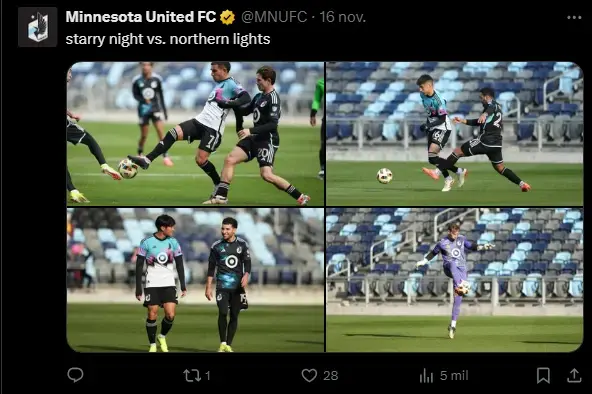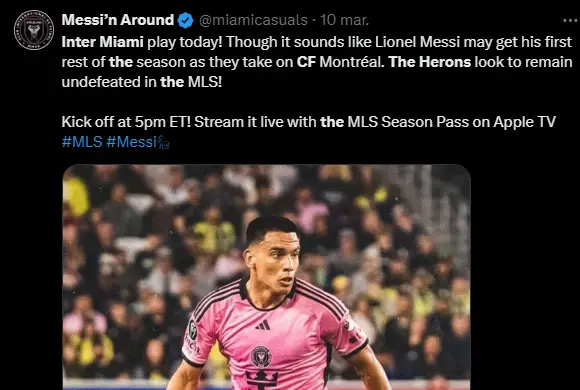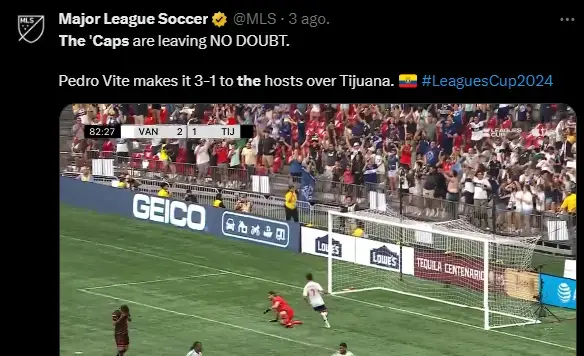The most strangest nicknames of MLS teams, do you know them?
Discover the most unusual nicknames that Major League Soccer (MLS) teams have adopted over the years.

Major League Soccer (MLS) has experienced remarkable growth in recent decades, not only in terms of soccer quality but also in the cultural richness brought by its teams. One manifestation of this diversity is reflected in the nicknames that franchises have adopted over the years. Some of these monikers are conventional, while others stand out for their originality and, at times, their eccentricity. Below, we delve into the most peculiar nicknames of MLS teams, exploring their origins and meanings.
The importance of nicknames in soccer culture
In the world of soccer, nicknames go beyond simple monikers; they represent a team's identity, history, and connection to its community. These names may derive from geographic, cultural, or historical traits and are often embraced with pride by both players and fans. In MLS, a relatively young league compared to others, nicknames have played a crucial role in shaping franchise identities and strengthening fan loyalty.
Nicknames that defy convention
"The Loons" – Minnesota United FC
Minnesota United FC is known as "The Loons". This nickname derives from the loon, a waterbird emblematic of Minnesota. The loon is recognized for its distinctive call and presence in the state’s lakes, making it a fitting symbol for the team. Additionally, the club’s logo features a stylized loon, reinforcing this identity. This nickname not only reflects local wildlife but also establishes a deep connection between the team and its natural surroundings.

"The Goonies" – San Jose Earthquakes
San Jose Earthquakes have been nicknamed "The Goonies," in reference to the 1985 adventure movie. This nickname emerged during the 2012 season when the team won several games in the final minutes, showcasing resilience and a fighting spirit reminiscent of the film's characters. The phrase "Goonies never say die" became a motto for the team and its fans, encapsulating their determination and ability to overcome challenges.
"The Black and Red" – D.C. United
D.C. United is known as "The Black and Red," a direct reference to the primary colors of its uniform. While it may seem like a straightforward nickname, it has been passionately adopted by fans and has become synonymous with the club's identity. The colors black and red symbolize strength and passion, traits the team strives to reflect in its on-field performance.
"The Five Stripes" – Atlanta United FC
Atlanta United FC is nicknamed "The Five Stripes", alluding to the five red and black stripes on their jersey. These stripes represent the club’s five foundational pillars: unity, determination, community, excellence, and innovation. This nickname not only describes a visual feature of their uniform but also encapsulates the values and philosophy the team promotes both on and off the field.

Nicknames inspired by local wildlife
"The Lions" – Orlando City SC
Orlando City SC is known as "The Lions." This nickname draws inspiration from the lion, a symbol of strength and leadership, which is prominently featured on the club’s crest. While Florida isn’t home to lions, the team adopted this symbol to reflect their ambition and competitive spirit. The lion is also represented by the team’s mascot, "Kingston," further solidifying this identity.
"The Herons" – Inter Miami CF
Inter Miami CF is nicknamed "The Herons". This moniker originates from herons, birds commonly found in South Florida. The club’s crest features two stylized herons, symbolizing the team’s connection to the region’s biodiversity. This nickname highlights the club's relationship with its natural surroundings and its commitment to the local community.

Nicknames rooted in culture and language
"Los Angeles Galaxy" – "The Galatics"
LA Galaxy has been called "The Galactics", referencing the term used to describe Real Madrid during their era of star-studded signings. This nickname gained popularity as the Galaxy began signing international superstars like David Beckham and Zlatan Ibrahimović. Although the term has European origins, its adoption by the Galaxy reflects the club’s ambition to become a global soccer powerhouse.
"The Boys in Blue" – New York City FC
New York City FC is known as "The Boys in Blue", referencing the primary color of their uniform. This nickname also establishes a connection with their sister club, Manchester City FC, which shares the same colors. Blue symbolizes loyalty and trust, values the team aims to embody in every match.

Nicknames derived from geographic features
"The Rapids" – Colorado Rapids
Colorado Rapids is simply known as "The Rapids". This nickname is inspired by the rapids of the rivers that flow through Colorado, reflecting the local geography and the energy the team seeks to display on the field. Additionally, the team’s name and nickname emphasize their connection to outdoor activities and nature, which are fundamental elements of the state’s culture.
"The Sounders" – Seattle Sounders FC
Seattle Sounders FC derives their nickname from Puget Sound, a large sea inlet defining Seattle's geography. The term "Sounders" not only highlights the region but also strengthens the bond between the club and the maritime community that shapes much of Seattle’s identity. Since its inception, this nickname has been embraced by fans as a symbol of local pride. Moreover, the team's stadium, situated near the water, reinforces this connection, making "The Sounders" more than a nickname—it's a declaration of belonging.
Humorous and creative nicknames
"The Caps" – Vancouver Whitecaps FC
The nickname "The Caps" for Vancouver Whitecaps FC is an abbreviation of their official name but also has cultural significance. The snow-capped mountains surrounding Vancouver, known as "White Caps," inspire both the team’s name and nickname. This term perfectly blends the natural landscape of the region with the competitive spirit of the club, making it a simple yet meaningful nickname.

The evolution of MLS nicknames
As MLS continues to grow and expand, team nicknames also evolve, adapting to new contexts and cultural influences. In some cases, nicknames arise from the fans themselves as a way of expressing loyalty and a sense of belonging to the club. In others, they are promoted by the teams as part of marketing strategies. Regardless of their origin, nicknames play an essential role in how teams are perceived both on and off the field.
Why nicknames are essential for MLS teams
Nicknames are not merely a superficial aspect of soccer; they encapsulate stories, values, and the essence of the teams they represent. In a league like MLS, where franchise identities are still being forged, nicknames help build an emotional connection with fans—a key element in the long-term success of any club. Additionally, in a market where branding is vital, these monikers become powerful tools to stand out and differentiate in the global soccer scene.
Conclusion: a league rich in identity
From the humorous "Sporks" to the representative "Loons" and "Sounders," MLS teams have shown that nicknames can be both a source of pride and a cultural connection. Each name, no matter how peculiar, tells a story and reinforces the unique identity of each club in a constantly growing league. As MLS seeks to establish itself as one of the world's premier leagues, these nicknames reflect not only diversity but also the creative and inclusive spirit that defines soccer in the United States.
More news

THE GANG IS HERE! First Argentine Stars Arrive in Buenos Aires for Final Qualifier Push!
01/09/2025

THE LAST DANCE! Lionel Messi Confirms His Final World Cup Qualifier in Argentina!
29/08/2025

TRANSFER COLLAPSES! Julio Enciso Fails Medical Exams, Returns to Brighton!
27/08/2025

Vini doesn't feel entirely comfortable at Real Madrid anymore and is seeking a future at another club
26/08/2025

HERE WE GO! Piero Hincapié Says YES to Arsenal, Club Prepares Final Bid for Leverkusen Star!
26/08/2025

THE REAL MADRID SHOWDOWN: Nico Paz's Future Sparks a Bidding War Across Europe!
25/08/2025

SOUTH AMERICAN SHAME: Independiente vs. U. de Chile Match Canceled After Horrific Incidents!
21/08/2025

Rodrygo Benched by Xabi Alonso: The End of an Era at Real Madrid?
20/08/2025

PARIS IN PARIS! The New Superclub, Paris FC, Rises to Threaten PSG-Marseille Rivalry!
20/08/2025

PSG’s €850M Budget is 30x Larger Than the Smallest in Ligue 1!
19/08/2025

THE DEBUTS ARE HERE! Estupiñán & Modrić Step Onto the San Siro Stage!
18/08/2025

CONTROVERSY IGNITES! Barcelona Opens Season with a Contested 2-0 Victory Over Mallorca!
18/08/2025

SCANDAL ESCALATES: Donnarumma's Harsh Letter Responds to Luis Enrique's Super Cup Snub!
15/08/2025

Franco Mastantuono: A New Number 30 for Real Madrid with a Nod to the Past
14/08/2025

HISTORY MADE! PSG Wins First-Ever Super Cup Title in Thrilling Penalty Shootout!
14/08/2025

Mastantuono Arrives at Valdebebas for Real Madrid Presentation
13/08/2025

ON AND OFF THE PITCH: Is Nicki Nicole the New WAG of Barcelona's Lamine Yamal?
13/08/2025

Donnarumma Bids Farewell to Paris Saint-Germain at the Peak of His Career
13/08/2025



